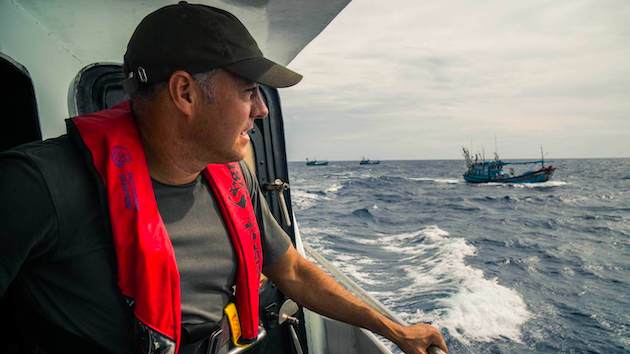
Late one night in 2017 New York Times journalist Ian Urbina found himself seated on the overheated bridge of an Indonesian patrol boat on the South China Sea. Sisyphean waves repeatedly jolted the boat, smashing against its sides, sounding like a car crash. Earlier that day there had been another kind of violent clash involving the boat when tense negotiations with a Vietnamese Coast Guard vessel over disputed fishing rights led the Indonesians to flee, leaving an officer behind with the Vietnamese.
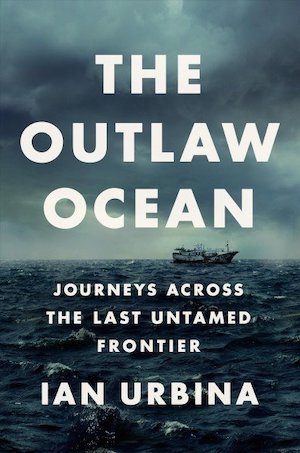 The mood on the bridge was of uncertainty and foreboding as the Vietnamese gave chase — an awkward silence replacing the usual Malay pop-music-infused playful atmosphere. As the boat pitched, an exhausted Urbina wrote up his notes from the day, listening to his playlist of ambient music, including Time from Hans Zimmer’s score for the 2010 film Inception.
The mood on the bridge was of uncertainty and foreboding as the Vietnamese gave chase — an awkward silence replacing the usual Malay pop-music-infused playful atmosphere. As the boat pitched, an exhausted Urbina wrote up his notes from the day, listening to his playlist of ambient music, including Time from Hans Zimmer’s score for the 2010 film Inception.
Time starts off slowly, kind of like Bolero but much shorter and packing more cinematic oomph, the sort that strategically targets emotional responses at plot points as it echoes the film’s narrative structure. Layered like a French mille-feuille pastry, it begins with a faint but steady low bass beat, then adds plaintive piano chord progressions followed by layers of instrumentation as exponentially swelling strings build to a crescendo that suddenly stops―then a brief caesura before a slow keyboard fade that emotionally reels the listener in.
Urbina uses music like Time as a mnemonic device to help him capture a feeling of a certain moment or place as he writes up reporting notes. Then, perhaps months later, when he revisits those notes, as he starts the writing phase of a project, he’ll relisten to that music and the associations and ambient emotions it triggers will transport him back to that experience.
When you listen to Time and then read the chapter “Fluid Borders” about the Indonesian patrol boat episode in Urbina’s 2019 New York Times Best Seller The Outlaw Ocean about lawlessness offshore, it deepens the storytelling experience. You can feel the mood of uncertainty and foreboding on the boat’s bridge.
Capturing the Moment With Sound
It’s not surprising that Urbina’s work-mode playlists feature ambient and electronic music. “It’s almost like Adderall — it helps me focus,” he told me in late October during a Zoom call from his car somewhere in metro Washington, D.C., where he lives with his family. Like Time, a lot of his focus playlists draw from film scores, including the Spotify one he sent me that included tracks by the artists Hammock, Max Richter, Ludovico Einaudi, and Mario Beltrami.
The way Urbina tells it, musicians and journalists are both storytellers — one using sound, the other leveraging words. That kindred connection is part of what led the 48-year-old to launch, about a year ago, his venture The Outlaw Ocean Music Project. As of early November 2020, over 400 musicians from more than 60 countries have translated his stories into music that is heard by millions globally on more than 200 music streaming platforms, including Spotify and Pandora, according to Urbina.
The project’s genres include downtempo, chill, hip-hop, lo-fi, jazz, and classical. I cooked dinner one night to the mellow lo-fi, hip-hop beats of Miscél’s EP The Rusty Kingdom (also a chapter in Urbina’s book). Miscél’s track E mare, libertas (The sea is free), refers to the national anthem of Sealand, a disputed micronation resting on a rusty World War II-era platform off the English coast, whose crazy saga of crime — from illegal pirate radio station to nefarious underworld dealings — Urbina chronicles. The pasta water boiled as I listened to the track’s smooth synth, imagining the scene of Sealand’s original owners on a sunny June day in 1967 (looking, in a black-and-white grainy photo from the event, a bit like brand ambassadors for the era’s Swinging London), standing on the platform, raising a sovereign flag in the salty sea air, and then perhaps slipping below to a cold concrete bunker for a celebratory nip.
Advocacy With a Beat
Using a meld of journalism, art, and advocacy is one way to raise awareness of environmental crimes and human-rights abuses offshore, explained Urbina. “To some degree, all of us landlubbers are complicit in these problems since we benefit from them,” he said. Roughly 90 percent of consumer products, from running shoes to smart phones, come by cargo ship, he said: “The reason we get these products so quickly and cheaply is partly because the high seas are unfettered by governments and rules.”
The world wants to believe, Urbina writes in his book, “that it is possible to fish sustainably, legally, and using workers with contracts making a livable wage and still deliver a five-ounce can of skipjack tuna for $2.50 that ends up on the grocery shelf only days after the fish was pulled from the water thousands of miles away.”
The reality, Urbina told NPR in 2019, is that embedded in that supply chain are all sorts of hidden costs, often illegal activity and inhumane activity, which is how companies save money.
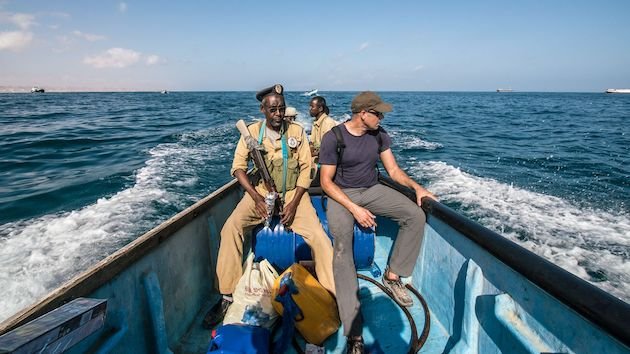
While the music project is an artistic experiment it’s also a way to re-examine traditional ways that journalism is consumed and funded. One of the project’s desired outcomes is to leverage the global reach of streaming platforms and turn them into news outlets, he said. That allows the project to push-out messaging about ocean issues to younger demographics, like his 17-year-old son, who might not otherwise read The New York Times (but will access news through alternate channels) by “going to their watering hole,” Urbina told me.
He used a chunk of his book advance as start-up capital to found the for-profit music label Synesthesia Media, which he owns, to run the project. Its business model is for the project’s streaming revenue to subsidize Urbina’s reporting endeavors through his nonprofit organization The Outlaw Ocean Journalism Project. That project is structured somewhat like the funding model for ProPublica, the nonprofit investigative journalism newsroom.
The music project is hitting its benchmarks, according to Urbina. “As a creative experiment, it’s already a success measured by the beauty and creativity of what’s been published,” he told me. The musicians are cultural diplomats on behalf of journalism, specifically, and more generally, on the issues of human rights, labor and environmental abuses at sea, he said. Streaming revenue will repay his music project start-up costs by early 2021, “using money I make after that to fund journalism projects,” said Urbina, a winner of the Pulitzer Prize and the George Polk Award for international reporting.
Other offshoots of his book include an option purchased by Leonardo DiCaprio and Netflix to adapt the The Outlaw Ocean into a feature film and a streaming documentary series. National Geographic is building a podcast about the project’s use of music to interpret ocean-related journalism. And a Lin-Manuel Miranda rap-style EP on Synthesia Media’s label is due in 2021 with some of Hamilton’s original cast members rapping songs inspired by Urbina’s reporting. “A huge moment for me personally and relevant to the music project was Hamilton,” said Urbina, a big hip-hop fan, who cut his teeth on Young MC and the Beastie Boys as a teen.
Urbina and his small but mighty Synesthesia Media crew cast a wide net for musicians from around the world. Part of the global conscription strategy is to get project artists talking about ocean issues in their respective geographies and spheres of influence. Urbina directly invites some musicians, others approach him after learning about the project through word-of-mouth, or from its website. The team and Urbina vet the musicians to ensure a strong fit aesthetically and a genuine interest in the concept behind the reporting. Artists are not paid an upfront fee, and co-own with the journalist each track they contribute, according to Urbina.
Several of the musicians told me contributing to the project has widely expanded their audience reach as previously-unknown-to-them bloggers write about their music as well as add it to their streaming playlists. According to Urbina, the combined ambit of the music and its connected videos is more than 90 million listeners and viewers. “My entire 20-year-career of writing for The New York Times did not garner me that kind of reach for this type of journalism,” he said.
New Focus in Dark Times
Most musicians seem to join the project because they’re interested in supporting the journalism and think the collaboration is an innovative idea, “creative minds are eager to find new things to try,” he said. And in many ways the pandemic has been a boon for the project, with cancelled tours and artists homebound. “I’ve got a lot of emails from artists who said, in these very dark times, this was something that gave them a sense of purpose and focus,” he told me.

He reached out to English composer and pianist Stephen Hough early in the pandemic, when London was in lockdown. Under normal circumstances, Hough’s dance card is full between travel, playing up to 100 concerts a year, and with commissions to write, Hough told me in a Zoom call from his London home in early November. Urbina’s invitation resonated for him. “I believe in the power of music to reach those parts that words can’t,” Hough said, adding, “and I do think that it can have a partnership with journalism but a partnership also with all kinds of things and can amplify the message.”
In their conversations, Urbina told Hough he wanted something that sparked an emotional response to the subject matter, according to Hough. For Hough, it was a creative process he already knew well. “What classical composers of songs from Schubert on are interested in doing,” he said, “is using harmony and melody to work with emotions.”
Hough started by reading many of Urbina’s articles about lawlessness offshore. “I’ve never been on a ship because I get seasick, even on the crossing to Staten Island, so it’s a world I don’t know,” Hough told me. The story of a sea slave named Lang Long moved him — “partly because he had a name and photograph so I could actually connect directly with him” — and inspired his track Lang Long’s Song for piano and tenor. “So immediately I thought ‘yeah,’ I want to write something that actually touches you,” said Hough, “that makes you feel the sadness of this man, the melancholy of that melody.”
Journalism as Anthropology
Urbina initially trained as a cultural anthropologist (stopping short of his Ph.D.) before going into journalism, “I wanted to be Jane Goodall when I was growing up,” he told me. The graduate training, he said, was later very helpful in doing long reporting projects: “Anthropology as a discipline inculcated in me a sense of otherness — anywhere you go with a story, you have already a ‘queer eye’ and I think that bettered me as a reporter.”
Raised in the Washington, D.C., area, Urbina is of Puerto Rican descent on his father’s side (retired federal judge Ricardo M. Urbina) and of Irish descent on his mother’s. Before our Zoom interview, I had read he was a vegetarian and wondered if extended reporting embeds on fishing boats played a role in that choice. But it wasn’t the case. He became a vegetarian while attending Georgetown on a track scholarship in an effort, he told me, to improve as an athlete “and because I had read a bit about the climate concerns tied to meat consumption, I stopped eating meat (and fish) though I was not vegan.”
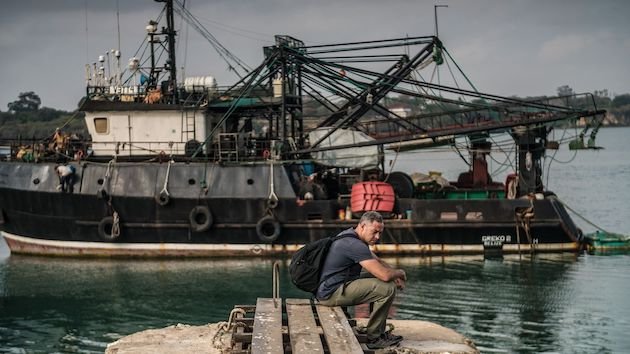
He said he isn’t religious about being a vegetarian. “In fact, when I am reporting, I eat whatever is put in front of me and I try to make sure to avoid allowing my own dietary habits to distract from the higher priority of integrating into the scene,” he told me. “So, on ships and in these contexts, I end up eating a fair amount of seafood (some of it gross, much of it delicious).”
After Georgetown, he enrolled in a cultural anthropology graduate program at the University of Chicago. He was conducting field work in the mountains of Mexico when he decided to discontinue his research there. “I loved Mexico but I never felt accepted,” said Urbina, who is half-black and bilingual in Spanish. “My Spanish was wrong. I was too tall. My complexion was wrong.”
He subsequently shifted his focus to Cuba. “The music came first,” he told me, “it was like a gateway drug in terms of becoming an addict to Cuba.” He got himself to Havana for a research year on a Fulbright grant. “In Cuba I felt at home,” he said, noting that on the racially mixed island, his skin tone, height, and Puerto Rican Spanish — closer to the more rapid-fire Cuban Spanish than that spoken in Mexico — made it easier to blend in. Eventually Urbina dropped out of graduate school and a few years later, in 2003, he joined The New York Times. (In 2019, he transitioned from a staff reporting role to that of contract writer for the Times, and he contributes to other media.)
Like a modern-day Margaret Mead, Urbina collected audio and video recordings over the five years he spent reporting on criminal issues offshore including human slavery, illegal fishing and overfishing, arms trafficking, and intentional dumping. (Many of those stories first ran in 2015 as a series in The New York Times.) “Anthropologically, music in my view is also an essential way to access and capture the culture of a place,” he told me. “What rhythms and sounds exist on the bridge of that ship or on the deck of that fishing vessel?” The audio recordings include rhythmic sounds such as captive fishing crews chanting on the South China Sea, machine-gun fire off the coast of Somalia, and conversations by Urbina and others. Musicians can draw inspiration from the sound and image archive, sample from it, or not.
Stretching Out
At first the project mostly focused on electronic, ambient, and hip-hop musical genres. One of the early contributors was French electronic composer and video artist Julien Amez (who records as Roger Molls). The Lille-based musician approached creating his EP by imagining it as a movie, with each song representing a book chapter that most inspired him. In a blurb on the project’s website, he described seeking an “epic, Homeric, orchestral, and cinematographic dimension to his music.” “The images came to my mind after reading the book,” Amez told me, “and then, above all, the videos, the real images of this incredible and unimaginable adventure.”
I noted Amez’s reference to Homer as well as an allusion to Odysseus’s maritime travels by a lo-fi artist in Germany, who titled his EP Odyssey. “I’m hoping to take the listener on the journey of The Outlaw Ocean,” said the Dresden-based Marc aka Misc.inc, on the project’s website. Unlike Odysseus, Urbina is not slaying cannibalistic cyclops or rescuing his men from the drugs of the Lotus Eaters. But there is something epic and Homeric about his odyssey of reporting on high seas crime, often at great personal risk.
Eventually Urbina began to reach out to more classical musicians, including San Francisco Bay Area composer Laura Sullivan. (Urbina said he has two classical playlists that include Chopin’s Nocturnes.) Sullivan was first intrigued about storytelling through music. Then she thought about the issues themselves. “It became clear to me that harm inflicted through crime at sea ... needs to continue to get more airtime, any way possible,” said the Grammy-winning artist, who composes for film and television. She incorporated many of Urbina’s recordings into her tracks. “I think they help to put a listener right there, on the sea, living the life these people are living, feeling what they are feeling,” she said.
I later asked Sullivan if working with Urbina’s field recordings and reporting to create her EP Born of the Sea (mostly inspired, she said, by the children affected by offshore crime) wasn’t akin to composing the soundtracks for film and television that she already does. She told me it was not similar. “When scoring for film or TV, I am asked to write music to create a mood that supports the story of the scene and that mood; that storyline is fixed and unmovable,” she said. “Ian was clear that this was not the point of The Outlaw Ocean Music Project — the point was for the music to tell its own story.”
Every Tune Tells a Story
Several days after our Zoom call, just before Urbina left for the Mediterranean Sea to report on the offshore world of rescuing refugees and immigrants, I asked him to elaborate on his personal relationship to music other than what he’d already told me. He emailed me back a riff, as he put it, that included the following: “On a very personal level that, given the option to watch something on TV or listen to music, I almost [always] choose the latter when I have free time. I think part of the reason is that while both experiences are forms of escapism, I prefer listening to music. It’s less captivating and controlling of my attention and leaves me more space and freedom to wander mentally. My relationship with music also rests on a certain amount of awe. I cannot read music nor play any instruments and I have distinct respect for the dedication over long periods that is required for musicians to become good at their craft. I also marvel at the unique type of creativity that is entailed in making this type of art.”
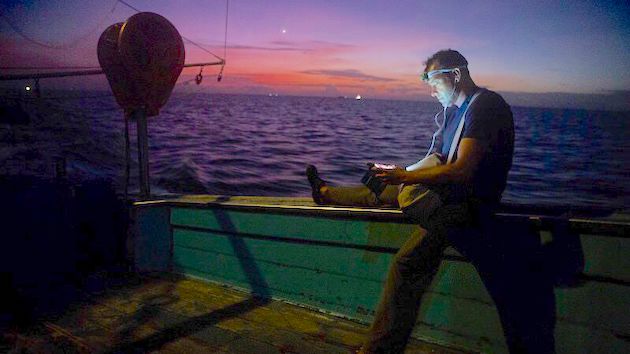
He first started thinking about the power of music to tell stories long before he began reporting on offshore crime. It began several years earlier on drives around the Washington, D.C., area with his then grade-school-age son and his friends. During those trips, they played a contest Urbina invented called The Imagination Game. He would play a snippet of music, the kids would close their eyes, and Urbina would cue them to use all of their senses to describe in rich detail the scene from the movie in their head the music inspired. The winner offered the most animated scene that fit the music. The way Urbina tells it, the game was a writing exercise. But the former athlete said it was also “an experiment in reverse engineering and a form of creativity calisthenics” that demonstrated music’s deep ability to tell stories.
“For me the synesthesia here is the crossover from sound to emotion,” he told me. “If you can imagine a moment you attempt to render in words, and you take that scene and hand it over to a skilled musician and ask them to focus on the emotion of that moment and amplify it, you’re going to access that spectrum of an accurate rendering of the moment. Is that new? No, that’s a soundtrack for movies.” And why should soundtracks be exclusive to films, he said. “Why can’t,” he asked, “a book have a soundtrack?”




